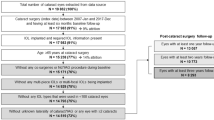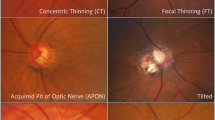Abstract
Purpose
To evaluate the influence of posterior capsule opacification (PCO) on GDx parameters in a population of pseudophakic, non-glaucomatous patients who underwent Nd:YAG laser capsulotomy (YLC).
Methods
The posterior capsules were photographed with a Topcon digital camera and each image was then entered into the EPCO 2000 software and evaluated independently by three examiners. The EPCO 2000 software was used to calculate the fibrosis index (FI) and the pearl index (PI) for the central 1.5, 2.5, and 3.5 mm of the posterior capsule. Scanning laser polarimetry was performed with GDx before and after YLC. We compared the GDx readings obtained before and after the YLC using paired Student's t-test. The parameters that varied significantly after YLC were subsequently used for regression analysis. Stepwise multiple linear regression was used to analyse the impact of the change in the amount of FI and PI on change in GDx parameters after YLC.
Results
In total, 158 patients were enrolled (74 men, 84 women). The mean age was 69.46±8.83 years (range 46–83 years). The interobserver agreement among the three experts was found to be good (repeatability coefficient R=1.51, 1.49, 1.49 for observer A vsB, A vsC, and B vsC respectively). One-sample Student's t-test show no difference between all GDx parameters before and after YLC except for Symmetry, Superior/Nasal ratio, Inferior Ratio, and Temporal-Superior-Nasal-Inferior-Temporal (TSNIT). Stepwise multiple regression showed that the two variables of greatest significance for changes in Symmetry were the FI in the central 1.5 and the PI in the central 3.5 mm (P=0.02). Superior/nasal ratio was shown to be most strongly correlated to the FI in the central 1.5 mm and PI in the central 3.5 mm (P<0.001), whereas the variable of greatest significance to Inferior Ratio was PI in the central 3.5 mm (P=0.03). Finally, TSNIT was most strongly correlated to FI in the central 1.5 mm and FI in the central 2.5 mm (P<0.001).
Conclusion
Presence of capsular fibrosis seems to be more clinically relevant in the central zone, whereas pearls tend to be clinically significant in the central 3.5 mm area. Hence, it might be worthwhile assessing the amount of PCO in pseudophakic patients when performing scanning laser polarimetry. Investigators should ensure that the type of PCO and the size of the area analysed are documented in the notes in order to interpret GDx findings appropriately.
Similar content being viewed by others
Log in or create a free account to read this content
Gain free access to this article, as well as selected content from this journal and more on nature.com
or
References
Wormstone IM . Posterior capsule opacification: a cell biological perspective. Exp Eye Res 2002; 74: 337–347.
Claesson MKL, Bechman C . Glare and contrast sensitivity before and after Nd:YAG laser capsulotomy. Acta Ophthalmol 1994; 72: 27–32.
Sunderraj P, Villada JR, Joyce PW, Watson A . Glare testing in pseudophakes with posterior capsule opacification. Eye 1992; 6 (Part 4): 411–413.
Aslam TM, Aspinall P, Dhillon B . Posterior capsule morphology determinants of visual function. Graefe's Arch Clin Exp Ophthalmol 2003; 241: 208–212.
Tetz MR, Auffarth GU, Sperker M, Blum H, Volcker HE . Photographic image analysis system of posterior capsule opacification. J Cataract Refract Surg 1997; 23 (10): 1515–1520.
Cheng CY, Yen MY, Chen SJ et al. Visual acuity and constrast sensitivity in different types of posterior capsule opacification. J Cataract Refract Surg 2001; 27 (7): 1055–1060.
Patton N, Aslam TM, Bennett HG et al. Does a small central Nd:YAG posterior capsulotomy improve peripheral fundal visualisation for the vitreoretinal surgeon? BMC Ophthalmol 2004; 4 (1): 8.
Aslam TM, Dhillon B, Werghi N et al. Systems of analysis of posterior capsule opacification. Br J Ophthalmol 2002; 86: 1181–1186.
Barman SA, Hollick EJ, Boyce JF et al. Quantification of posterior capsular opacification in digital images after cataract surgery. Invest Ophthalmol Vis Sci 2000; 41 (12): 3882–3892.
Findl O, Buehl W, Menapace R et al. Comparison of 4 methods for quantifying posterior capsule opacification. J Cataract Refract Surg 2003; 29: 106–111.
Aslam TM, Patton N, Graham J . A freely accessible, evidence based, objective system of analysis of posterior capsular opacification; evidence for its validity and reliability. BMC Ophthalmol 2005; 5 (1): 9.
Rhee DJ, Greenfield DS, Chen PP, Schiffman J . Reproducibility of retinal nerve fiber layer thickness measurements using scanning laser polarimetry in pseudophakic eyes. Ophthalmic Surg Lasers 2002; 33 (2): 117–122.
Author information
Authors and Affiliations
Corresponding author
Additional information
Competing interests: The authors have no financial or other interests in any of the products mentioned
Rights and permissions
About this article
Cite this article
Vetrugno, M., Masselli, F., Greco, G. et al. The influence of posterior capsule opacification on scanning laser polarimetry. Eye 21, 760–763 (2007). https://doi.org/10.1038/sj.eye.6702323
Received:
Accepted:
Published:
Issue date:
DOI: https://doi.org/10.1038/sj.eye.6702323



